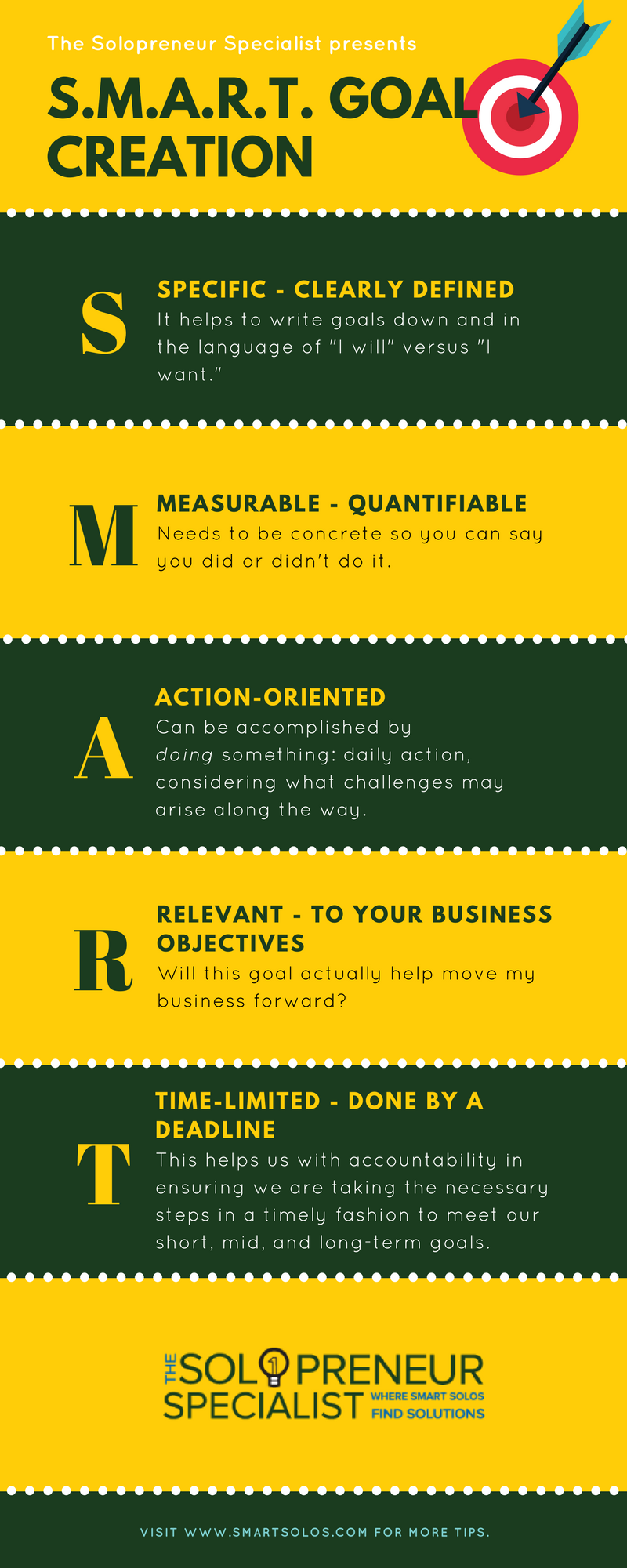The Solopreneur Specialist
Monthly Newsletter
A question for all my readers: As you’re enjoying this year’s holiday season, take a moment to review the goals you set for your business this time last year. Did you make New Year’s resolutions about how you would achieve them? If so, how did 2017 measure up?
For those who were brave enough to commit your resolutions to paper, this is a good time to compare your intentions to what actually happened. Did your goals remain the same throughout the year, or did they change at some point? Did you surpass them or fall a little short? And either way, how did your priorities and actual day-to-day activities affect the outcome?
Quite honestly, it’s rare that small business owners look back and are fully satisfied with the past year. It’s easy to lose track of your goals–where you wanted to be and how you planned to get there, when days fill up with tasks that distract you with the here and now.
The goals you set shouldn’t be a one-time exercise that’s forgotten until the following year. To stay on track, you should display them somewhere that you’ll see them every day. And when you’re tempted to spend your time on something that doesn’t move your business forward (hello, Facebook!), let them remind you of what’s important.
So what will you do differently next year? Start deciding now what you want from 2018. What areas of your life and your business will you change? What will your goals be? And what will you need to do to reach them?
For those of you who’ve read my book, There’s No Place Like Working from Home, you’ll know that it’s important to have a clear vision of what you want your business to be in one year’s time. Even more important, however, is to plan the concrete, actionable steps you’ll need to take between now and then. And add a deadline by which you’ll complete each step. You may have heard the comment attributed to Robert Herjavec, one of the sharks on Shark Tank, “A goal without a deadline is just a dream.”
As you decide your goals and plan your priorities for 2018, remember the following tips from my book: Goal-Setting: Set Long-Term, Mid-Term, and Short-Term Goals
Goal-Setting: Set Long-Term, Mid-Term, and Short-Term Goals
Long-Term Goals
Where would you like to see your business, in say, 5 years? If your vision is to become a highly sought-after speaker, think about the complimentary goals and activities that can pave the way. For example, establishing yourself as an expert by writing a book requires a significant investment of time, but will absolutely heighten your visibility. Writing a book will distinguish you from the thousands who think about it, and that’s all they do. Start now to meet the interim goals that will make your vision a reality!
Mid-Term Goals
Long-term goals are too big to think about as a single event. It’s easier and more practical to create goals and set deadlines for mid-term goals that will lead to your long-term goals. They should be steps you can achieve within a year or so. In the example above, you might create mid-term goals of landing one or two public speaking engagements at industry conferences or civic groups. Or get your book underway with a timeline laying out when you’ll have your outline done, when you’ll have a draft of each chapter completed, etc. Mid-term goals keep the big picture in sight without feeling so overwhelmed.
Short-Term Goals
Decide the specific actions you will take this month or this quarter that will help you get to your mid and long-term goals. Perhaps you recognize you’re speaking skills need polishing and it would make sense to join Toastmasters. You could start research for your book by scheduling an interview each month with other experts in your industry.
As you’re generating your goals, you’ll want to follow the SMART guidelines listed below (click to enlarge):
Next month, we’ll look at ways to recognize and prioritize the actions that will help you realize your vision for your business.
Happy Holidays to you all; I send my very best wishes for your success in 2018!









